Compulsivity and Impulsivity
Examining Compulsivity and Impulsivity to Understand Addiction
 Graphics courtesy of Neuroscience NewsOpens in new window
Graphics courtesy of Neuroscience NewsOpens in new window
To clearly discuss the concept of compulsivity, it is essential to discuss its relation to impulsivity, a multifaceted construct bearing numerious possible definitions. |
Key elements of impulsivity include a predisposition toward rapid reactions, automatic and quick response to desires, insensitivity to delayed rewards and lack of reflection when making decisions.
Although healthy individuals may possess impulsive personality traits, excessive impulsivity is a key defining feature of many neuropsychiatric conditions, including attention deficit/hyperactivity disorderOpens in new window, substance use disorderOpens in new window, antisocial behaviorOpens in new window, as well as many behavioral addictions.
Compulsivity refers to persistent or perseverative behavior that’s inappropriate to associated things, which have no obvious relationship to an overall goal.
- Compulsive behaviors are typically unpleasantly monotonous and done as habits.
- Compulsive behaviors show hanging persistence, generally enduring for long periods despite beign harmful to the individual.
Compulsiveness may be a hallmark of many psychiatric conditions and is determined most notably in neurotic disorder (OCD). Alternative conditions that are thought to exhibit compulsive options embody uptake disorders, substance dependence and behavioral addictions like compulsive Internet use.
The same as impulsivity, compulsiveness might arise from failures in response inhibition or “top-down” reasoning, associated over-stimulated drive state, or a mixture of those factors.
Clinical observation has shown that patients with primary impulsive psychopathology (addictive gambling or addictive gamingOpens in new window) might demonstrate neurotic options, whereas patients with primary compulsive psychopathology (e.g., OCD) might score high on impulsivity ratings, and/or have impulsive-aggressive symptoms or comorbid impulse management disorders.
Additionally worth noting is that overlapping impulsive and compulsive options might develop in otherwise equivalent disorder. Totally different trajectories of impulsivity and compulsiveness among single disorders complicate the manner in which these disorders are understood by clinicians, also on how they’re treated.
Rather than considering the two constructs as polar opposites, an alternate and additional realistic position is to contemplate impulsivity and compulsiveness as orthogonal factors across a variety of disorders, wherever either construct could be identified, there is a likelihood, higher or lower for the availability of the opposite construct.
Now, addictionOpens in new window provides a very important opening into debates regarding compulsiveness and impulsivity. Current psychobiological models perceive addiction as transition between impulsive and compulsive behavior.
Impulsivity may be at the foundation of an inclination to pursue short-run rewards led to by addictive behavior and substances and is a powerful mechanism within the early stages of addiction (thus, problematic use or abuse).
With regular engagement in addictive behavior or use of substance over extended amount of your time, impulsivity as a learning mechanism becomes over-trained and then develops into compulsive habits.
Two vital options of habitual behaviors and substance taking are:
- the behavior is driven by associations triggered by stimuli and not by an evident goal/reward; and
- the individual is unable to reverse the repetitive activity pattern, therefore resulting in compulsive behavior.
In biological science terms, the transition from voluntary action in behavior or substance use to a lot of habitual or compulsive modes looks to represent a shift in brain systems.
This shift on top of things correlates clinically with a move aloof from absolutely strengthened behavior actuated by reward seeking in problematic behavior or drug abuse toward negatively strengthened behavior actuated by the rejection of withdrawal symptoms in full-blown dependence and addiction.
Impulsivity plays a significant role in the early stage of addiction while maladaptive learning processes and habit formation lead to the development of compulsive behavior in the later stage of addiction. The two should not hence be taken as parallels, but rather as one that builds on another. Dealing with impulsivity may help prevent addiction, but dealing with compulsivity may help in treating addiction.
In summary, a psychological cum philosophical perspective of addiction views addiction as a product of psychological maladjustment and functional impairment.
The series:
- What Is Addiction (Biological Perspective)?Opens in new window
- What Is Addiction (Psychological Perspective)?Opens in new window
- Addiction and Voluntary ActionOpens in new window
- Treating Addiction and Avoiding RelapseOpens in new window
- Compulsivity and Impulsivity (as related to Addiction)Opens in new window
- What is Substance Addiction?Opens in new window
- Gambling Disorder (What Is Pathological Gambling?)Opens in new window
- What Is Food Addiction?Opens in new window
- What Is Internet Addiction?Opens in new window
- Blum K, Cull JG, Braverman ER, Comings DE (1996) Reward deficiency syndrome. Am Sci 84: 132 – 145.
- Broadie S, Rowe C (2002) Aristotle: Nicomachean ethics. Oxford University Press, Oxford.
- Dalley JW, Everitt BJ, Robbins TW (2011) Impulsivity, compulsivity, and top-down control. Neuron 69: 680 – 694.
- Di Chiara G (1998) A motivational learning hypothesis of the role of mesolimbic dopamine in compulsive drug use. J Psychopharmacol 12:54 – 67.
- Ersche KD, Clark L, London M, Robbins TW, Sahakian BJ (2006) Profile of executive and memory function associated with amphetamine and opiate dependence. Neuropsychopharmacology 31(5): 1036 – 1047.
- Evenden JL (1999) Varieties of impulsivity. Psychopharmacology 146:348 -361.
- Everitt BJ, Robbins TW (2005) Neural systems of reinforcement for drug addiction: from actions to habits to compulsion. Nat Neurosci 8: 1481 – 1489.

